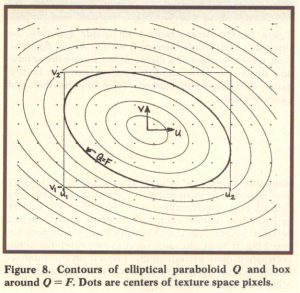...
- An important but not always evident aspect of the EWA algorithm is a further adjustment of the weighting factors to implement a gaussian filter to the projection processing. The gaussian filter is important to minimizing the possible effects of aliasing and moiré effects when down-sampling a larger array of source data to a smaller set of target data.
| Expand |
|---|
|
- The topic of aliasing and moiré effects in digital image processing is complex. In brief, and perhaps unsatisfyingly so, anytime you digitize at a specific resolution, or "down-sample" from a higher resolution to lower resolution, it is possible to introduce patterns of imaging that suggest lines or curves that are not present in the original or source image.
- Here is one article that describes the effect, both in terms of audio sampling (where I first encountered this) and in video sampling: https://matthews.sites.wfu.edu/misc/DigPhotog/alias/index.html. (That is from a physics professor at Wake-Forest U., in North Carolina. An interesting site, and not a bad explanation of what is happening).
- There is another article that correlates the frequency domain analysis and the various discrete filtering techniques in image processing, suggesting further that the gaussian filter used in EWA is an important if not perfect mechanism to reducing aliasing and moire patterns. I can’t claim to fully understand this, but it does correlate the image processing world with our reprojection efforts. Note that wherever the reprojection mapping of source data to target projection results in “downsampling” of an input area to an output area - aliasing can occur if some kind of interpolation filtering is not applied. This is not uniform across the output dataset, as reprojection itself is not uniform, but very often applies in some area of the output: https://www.strollswithmydog.com/downsizing-algorithms-effects-on-resolution/#more-954.
- I’m reminded that HEG chooses a higher output resolution that minimizes downsampling effects (eliminates?), while GDAL chooses an output resolution that preserves overall grid sizing, generally at a lesser resolution, and that can introduce downsampling artifacts. While HEG's approach may not eliminate the issue (TBD), it certainly does minimize the issue somewhat.
|
The algorithm itself
What follows is a very cursory pseudo-code description of the algorithm, hopefully highlighting the important aspects, and not leaving out any significant details, while not overwhelming with detail.
| Expand |
|---|
|
For each point in swath (per row, per column)
Pre-Calculate ll2rc – lat/lon-to-row-column
(giving floating-point row/col in target space, not integer row/col)
For each row-set in swath (rows-per-swath)
Compute_ewa_parameters: (ellipse parameters per column)
For each column in swath
<compute ellipse parameters>
Use values in adjacent columns for horizontal delta of ellipse calculation
And first row of row-set to last row of row-set, averaged over the number of rows
for the vertical delta of ellipse calculation.
Compute_ewa: (output values per target grid cell)
For each row in row-set
For each column in swath
<assign values for recurring factors >
<get ewa_parameters for row & column (ewa_parameters, ellipse)
<compute perimeter box for ellipse >
For each target row in perimeter box
For each target column in perimeter box
If target point within ellipse
Compute/Lookup weighting factor
Numerator_array(target_cell) += weighted-distance # grid_accums
Denomitnator_array(target_cell) += weights # grid_weights
Target_Values = Numerator_array / Denominator_array # output_grid
The original article shows the calculation of the perimeter-box for the ellipse as follows: 
|
...
